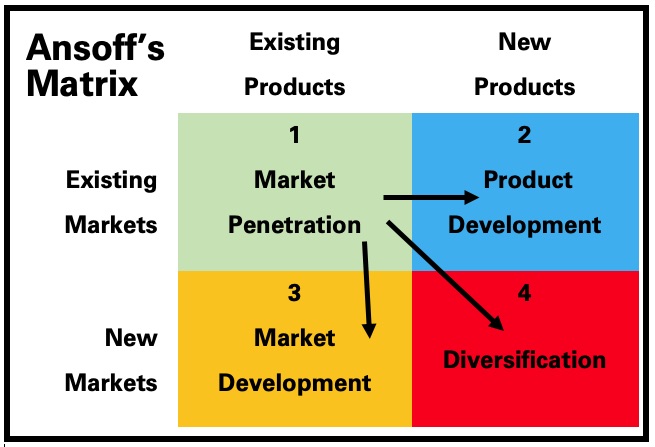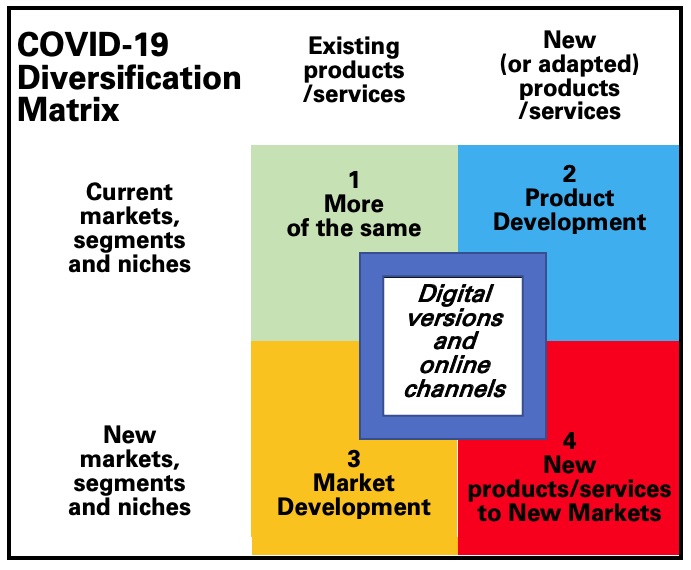During the pandemic, many businesses are developing COVID-19 Diversification strategies. These can be simply emergency tactics for the short term, or more fundamental strategic changes for the medium term. Some businesses will later return to ‘normal’ (or the ‘new normal’) whilst others will be completely transformed, emerging with a new business model (or Business Formula). Some creative entrepreneurs will take the opportunity to RE-Design their creative businesses, to adapt to new realities and achieve even greater success.
Businesses are adapting, diversifying, pivoting, innovating, reorganising etc. All these words are used to describe the reactions of businesses but one word in particular is important: Diversification. What does it mean in different contexts? What are our options for diversification? Can we use different methods of diversification? How do we map out our diversification options? How do we achieve a more diversified business model?
UPDATE: This concept, plus other techniques and strategies for diversification during the crisis are part of a new online course: ‘COVID-19 Business Strategies: Creativity, Diversification and Transformation’.
The word ‘Diversification’ was used by Igor Ansoff in his book and its famous matrix (Ansoff’s Matrix or the Ansoff Matrix) in a precise way, to mean developing new products or services, for new markets. Of the four options in his matrix, 4. Diversification (as in his meaning of the word) is by far the most risky, because it combines two unknown factors. Two other options (2 and 3) in his matrix are much less risky because they are partly known, partly unknown. Option 1, to remain much the same, but do more of it, is less risky in terms of change, but carries its own risk, especially in a turbulent business environment- or a global heath and financial crisis brought about by the Coronavirus/COVID-19 pandemic.
As part of the Creative Responses to the Crisis, COVID-19 Diversification options can be explored using an adapted version of the Ansoff Matrix to think strategically, map out options, generate new ideas and make crucial business decisions for the short term and long term. But first, let’s look at the original version of the Ansoff Matrix.
Ansoff proposed four strategies for growth which can be neatly summarised in the matrix above:
1. ‘Market Penetration’ means selling more of existing products to existing markets. This is a matter of increasing market share without developing new products or approaching new customer segments.
2. ‘Product Development’ means growing through existing customer segments by offering new products to them.
3. ‘Market Development’ refers to selling existing products to new customer segments.
4. ‘Diversification’ – means doing two things at once: developing new products for new markets. (Ansoff used the word Diversification with this particular meaning, whereas we are now using it in a looser way.)
Ansoff’s matrix provides a very simple but very effective focus for considering different options for growth, and provokes debate about whether to find new customers for existing products [3], offer more products to the existing customer base [2], or stay with existing products and gain a greater share of the current market [1]. Diversification [4], which is often the instinct of ambitious businesses, is the most risky growth strategy, because as the matrix shows so clearly, it means leaving the safety zone of both existing customers and existing products into a region of two unknowns: new products and new markets.
Note: Diversification can be achieved in a less risky way by moving horizontally then vertically, or vice versa, rather than diagonally across the matrix. This is analogous to a board game in which the player can take two moves to get from square 1 to square 4.
The new COVID-19 Diversification Matrix
This adaptation of Ansoff’s Matrix takes into account new opportunities in the Digital Economy.
In the digital age, there are new opportunities for diversification since existing products/services can often be adapted into digital products/services, or delivered through online channels, to current customers or new ones. This provides many more options.
(Note: ‘Products’ means products or services. ‘Markets’ means market segments, niches and customers.)
Ten COVID-19 Diversification Strategies:
A. Keep the current business model and go for market penetration, in other words more sell more product to current markets.
B. Product development by selling new products to existing markets (as per Ansoff).
C. Product development by selling adapted or digital versions of existing products to current markets.
D. Product development by selling existing products to current markets through online channels.
E. Market development by selling existing products to new markets (as per Ansoff).
F. Market development by selling adapted or digital versions of existing products to new markets.
G. Market development by selling existing products to new markets through online channels.
H. New Business Model by selling new products to new markets (what Ansoff meant by the word Diversification).
I. New Business model by selling new digital products to new markets.
J. New Business model by selling to new markets through online channels.
In addition to these one-stage moves, a business might move from square 1 to square 4 in two stages, through squares 2 or 3, as in a board game.
It is more likely that businesses will develop new business models by moving through product development or market development stages first.
Through this process, some creative, cultural and digital enterprises will transform their business models completely.
This new ‘COVID-19 Diversification Matrix’ can be used to generate several COVID-19 Diversification ideas and options, which can then be evaluated and prioritised using the Feasibility Filter. In this way it can be used to devise smart strategic responses to COVID-19 and map out an action plan.
Some examples of the ten strategies:
A. Computer games companies. Netflix. Selling a lot more during COVID-19 to existing market. No need to diversify or change business model.
B. Restaurants selling takeaway meals for the first time to their existing customers.
C. My own books, adapted from paperback editions to digital editions (eBooks and Audiobooks) to sell to the current creative industries markets.
D. E-commerce website designers. Selling to new customers such as small retailers needing a new online shop. Using wholly online sales channels.
E. Black Gold Engineering in Namibia. Innovative LED street lighting company. Currently selling LED lighting for new hospital isolation units. New market.
F. (and C and D) My own business. Adapting my training workshops and materials for online Zoom webinars to current and new markets.
G. Willis Brothers. A fruit and vegetable stall on Bury market, now selling their products online, to existing and new customers. Didn’t need a website before.
H. Manufacturers switching production to healthcare products (ventilators, masks, hand sanitiser etc) for a healthcare market they didn’t serve before.
I. Watch this space! This will happen.
J. Watch this space! This will happen.
Please contact me with more examples and let me know your own experiences of diversification in the COVID-19 crisis.
This article was republished with permission on the International Arts Manager blog.
Contact David about republishing other content from this website to help creative entrepreneurs in the cultural, creative and digital industries.
COVID-19 Diversification Strategies using this new COVID-19 Diversification Matrix is part of my online workshop on creativity and innovation during the COVID-19 crisis (more…)
Read about other events, webinars, interviews, articles, resources and online business advice sessions, which are part of David’s response to the Coronavirus COVID-19 Crisis. The page includes videos of past events as well as notice of forthcoming events, plus some suggestions for future collaborations (more…)

